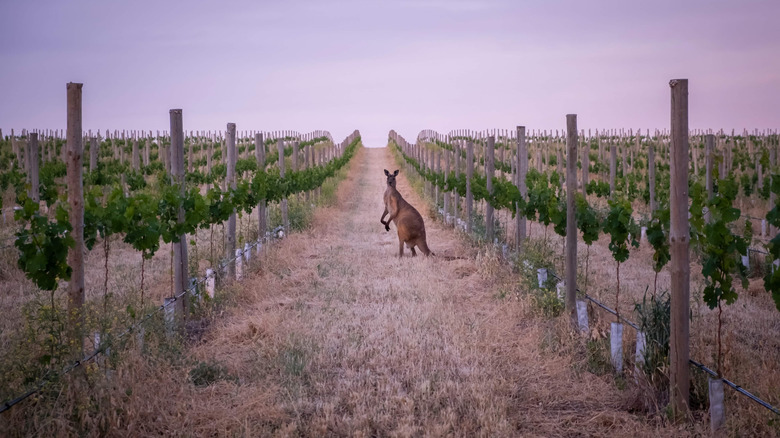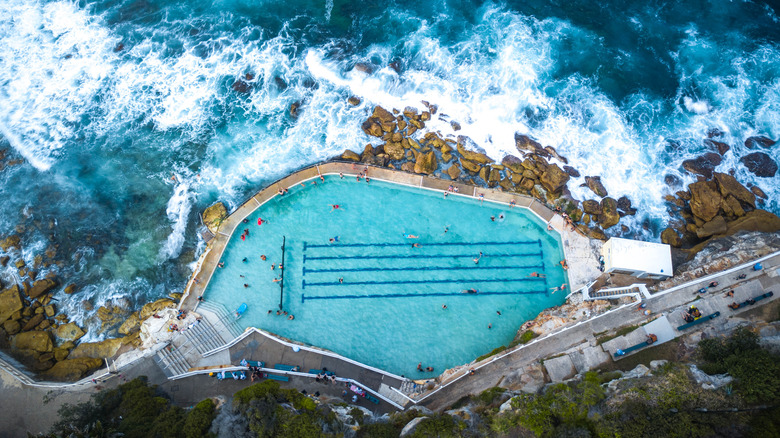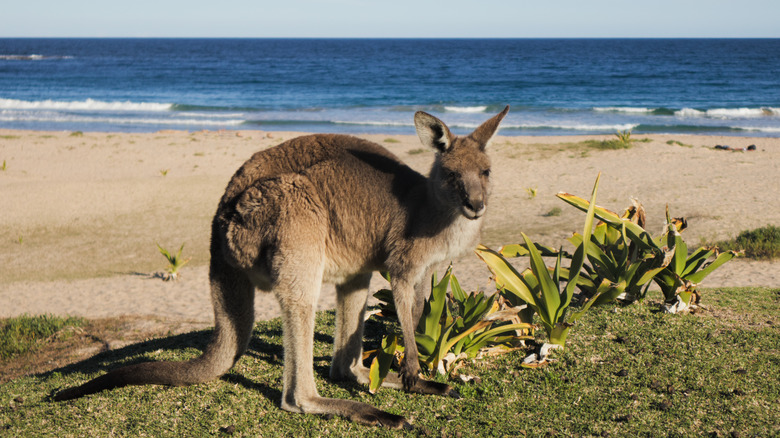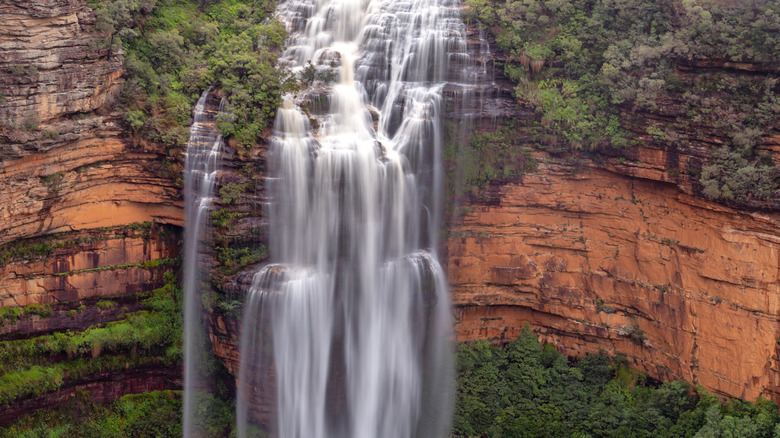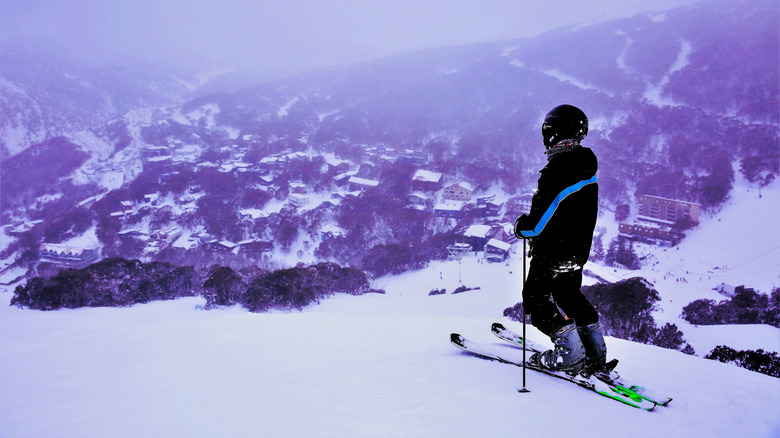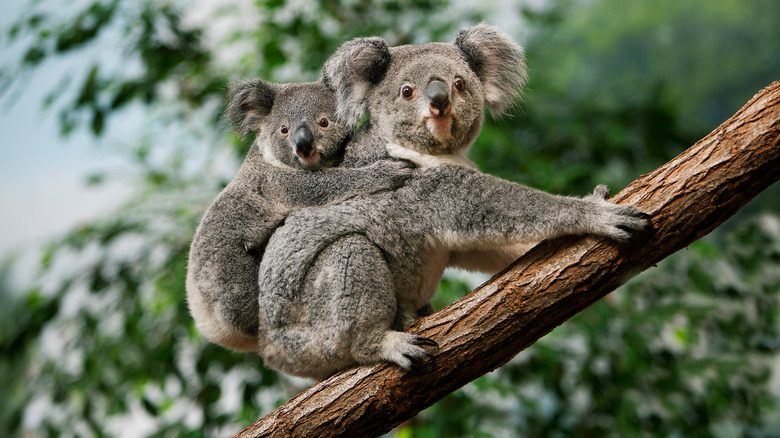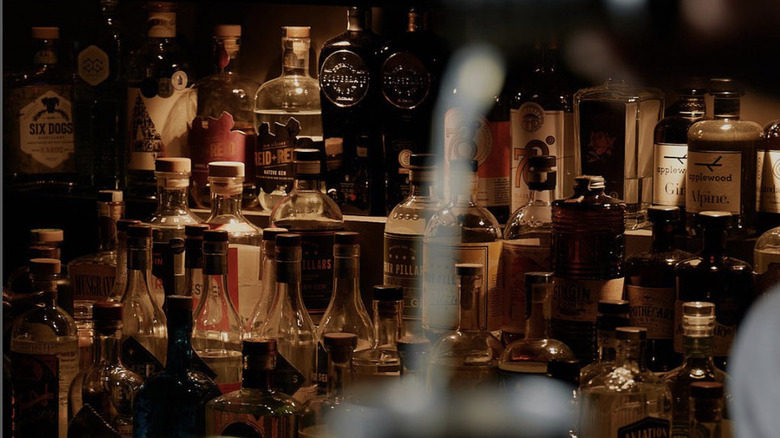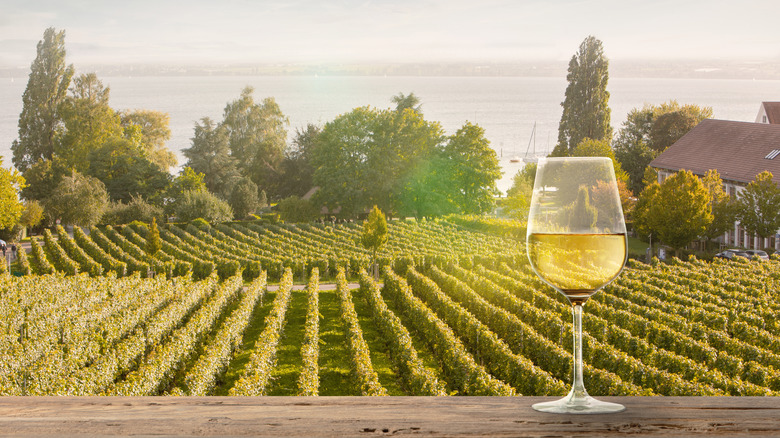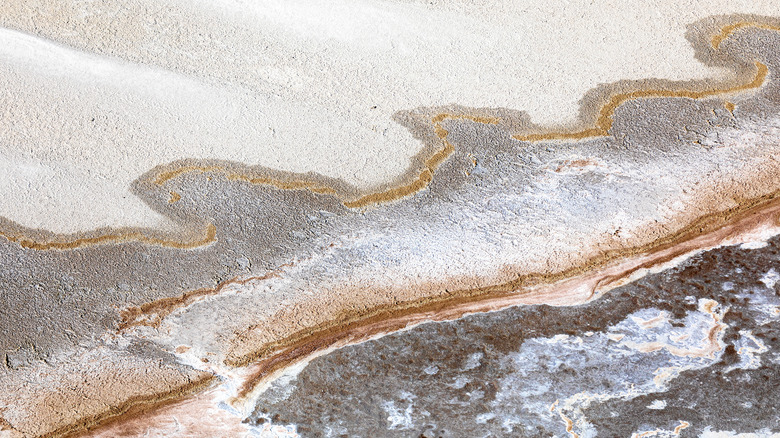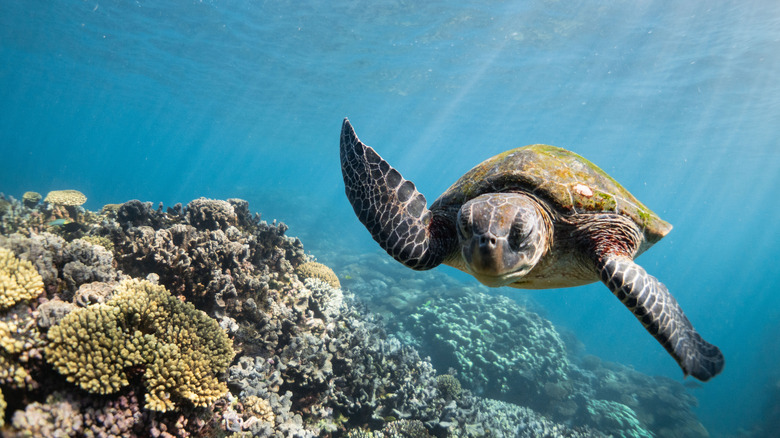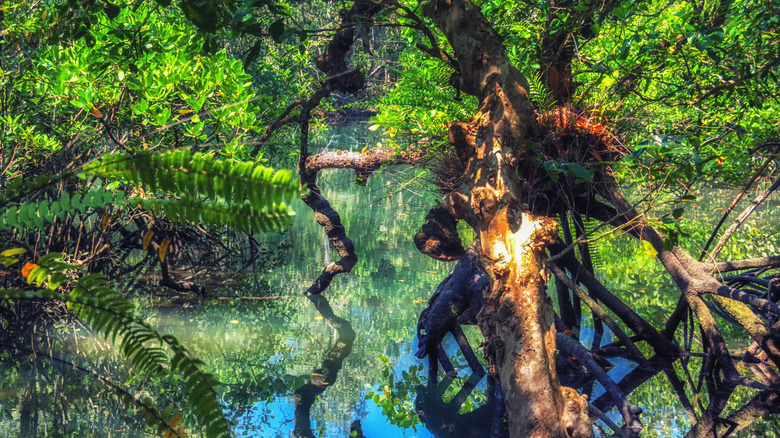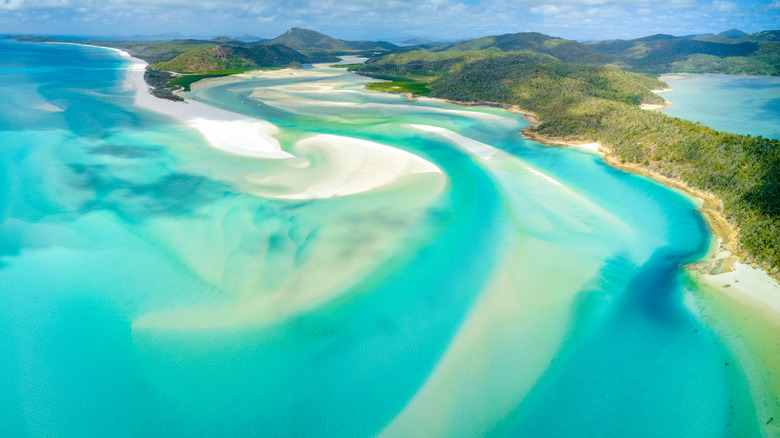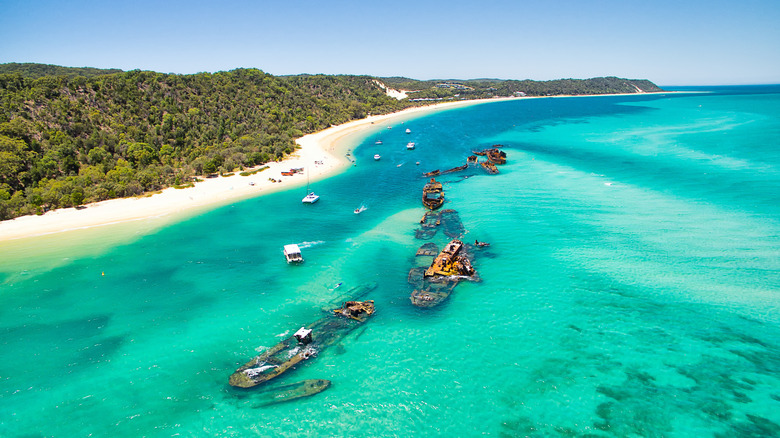Hidden-Gem Destinations To Add To Your Australian Bucket List
Say "Down Under," and you may picture a kangaroo hopping past the Sydney Opera House or something similarly stereotypical, but there's so much more to Australia, a nearly 3-million square-mile island featuring almost every climate topography and loads of flora and fauna found nowhere else on Earth. As such, Australia is a popular tourist destination with a well-worn standard itinerary. But we dug through reams of traveler reviews, guides, and tours to uncover some of the country's most magnificent hidden gems.
We start in Sydney and move clockwise around this magnificent landmass. We hoped to find something for everyone, whether you like buzzy big cities, the stark beauty of the Outback, the vibrant beauty of coral reefs, or the bizarre thrill of skiing down a mountain in July. And yes, there are plenty of kangaroos and koalas to go around — by all reports, they're all over the place. So grab your khaki shorts, flip flops (Aussies call those a name we don't care to repeat here), sun hat, and your surfboard, and travel with us to some of Down Under's best under-the-radar spots.
Rock Pools, New South Wales
We could do an entire article on the hidden gems in Sydney alone, which include everything from an alley full of ornate hanging birdcages to a foodie paradise called "Spice Alley." But there's something about ocean waves crashing into a pool that feels adventurous, epic, luxurious — in other words, quintessentially Australian.
Sydney has roughly 40 rock pools, or saltwater pools carved out of rock at the ocean's edge, at just about every one of its beaches. These infinity-style pools allow swimmers to enjoy the thrill and chill of swimming in the ocean, just with better views and less risk of riptides. Still, many swimmers report thunderous waves crashing into the pool, often bringing fish and the occasional octopus.
A popular way to experience some of the best pools is by walking along the Bondi to Coogee Coastal Walk, an iconic 3.7-mile walk along the cliffs from Bondi Beach in the north to Coogee Beach. Along the way, you'll find Bondi Baths, an eight-lane, 50-meter saltwater pool in the cliffs, and Bronte Baths, a 38-meter pool with a walkway leading straight into the ocean. Most pools have regular clubs like Bondi's "Icebergs," who make it a point to swim there as often as they can, even in the frigid winter. Unless you're made of really hardy stuff or are half-penguin, we recommend swimming in these pools in the warmer months.
Pebbly Beach, New South Wales
You asked for Australian gems, and nothing quite says "Oz" like a beach full of kangaroos. That's precisely what you'll find at Pebbly Beach, located about four hours southwest of Sydney in Murramarang National Park.
Kangaroos can be found hopping all over Australia, particularly at the famous Kangaroo Island southwest of Adelaide, although the island can be packed with both kangaroos and human tourists. Pebbly Beach is an under-the-radar place with deep blue water great for surfing, rocky cliffs for fishing, sea caves for exploring, and green bushland where friendly eastern gray kangaroos graze peacefully. Visitors have also reported seeing dolphins jumping and sea eagles and peregrine falcons soaring above. There's even a myth that some of the kangaroos surf (which scales new heights of Australian stereotypes), but that reportedly arose from a photo where a kangaroo was standing at a funny angle in the low surf.
If you want to spend as much time with the kangaroos as possible, consider setting up a tent in one of the beach's campgrounds or booking any number of nearby cabins or houses. Murramarang National Park is also a more than 12,000-acre park spanning 27 miles of coast, and it provides ample opportunities for hiking, kayaking, swimming, surfing, or embarking on the scenic three-day Murramarang South Coast Walk through miles of beautiful ocean and forest.
Blue Mountains waterfalls, New South Wales
The Blue Mountains, less than an hour's drive west of Sydney, are a symphony for the senses. You can enjoy verdant valleys of bushland, craggy cliffs, and dense forests, but one of their most enchanting attractions is its many waterfalls. Some, like the epic Katoomba Cascades or the multi-tiered Empress Falls and its swimming hole at the bottom, are better known, but dozens of other falls flow right under the radar.
If you like glowing caves, try Horseshoe Falls, an incredible waterfall with a cave behind it from which you can view the falls. Thousands of glow worms live inside the cave. At night, it becomes an eerily beautiful constellation of neon green dots. Nearby, Cataract Falls offers another glowing cave. If you want to feel like you're completely inside a cave while viewing a waterfall, visit the atmospheric Grotto at Centennial Glen, which will place you at the bottom of a pool, surrounded by towering rocks on every side, looking at a narrow waterfall flowing in. For another enchanting pool experience, head to Minnehaha Falls or Grey Hat Falls, where emerald green swimming holes surrounded by bushland and sandstone gaze at quickly cascading streams of water.
Falls Creek Alpine Resort, Victoria
Head to the country's far south in July or August, and you'll find ... an Alpine ski resort? That's the Southern Hemisphere for you. Skiing may not be the first thing that comes to mind when you think of Australia — or July — but it actually boasts quite a few substantial resorts. Falls Creek is not the biggest — that honor goes to Perisher — but we picked it because, as its name suggests, it boasts a charming Swiss-style chalet village, complete with restaurants, bars, nightclubs, spas, and more than 4,500 beds.
Located high in the Australian Alps, the resort also claims consistent snowfall, covering 1100 acres of 90 different runs and 15 lifts. The resort is known for being especially friendly for beginner and intermediate skiers, with 80% of its runs catering to them. In addition to skiing and snowboarding, the area offers several winter activities, including tobogganing, snowshoeing, back-country touring, and cross-country skiing. Head over during the first week in August to see the Kangaroo Hoppet long-distance cross-country skiing race. Or, in the summer, enjoy an alpine paradise perfect for camping, cycling, swimming, hiking, and more.
Koala Reserve, New South Wales
You've seen kangaroos at the beach — now it's time to see some koalas in the trees. The Narrandera Nature Reserve, more commonly known as the Koala Reserve, was established in the 1970s to bring back koalas that had been hunted to extinction roughly 70 years earlier. Fifty years later, the experiment has been a big success. It's estimated that the koala population has jumped from just 19 in 1972 to over 290 today.
Grab a seat on a picnic table near the Murrumbidgee River and watch the adorable little marsupials chewing on the leaves of the red river gum trees, swinging from branch to branch, or cuddling each other while fast asleep. For the best koala views, experts recommend visiting between December and February, when the heat causes koalas to leave the trees and search for cooler locations.
Once you've gotten your fill of koala-watching — if such a thing is possible — enjoy the nearly 4,000 acres of Murrumbidgee Valley National Park, a remote area of bush and wetlands about five and half hours north of Melbourne and four hours west of Canberra. It's a great, secluded spot perfect for camping, cycling, kayaking, fishing, canoeing, or all of the above. In addition to koalas, you're likely to spot more kangaroos and a large gathering of beautiful birds, from spoonbills to swamphens to sandpipers.
Hidden bars, Melbourne, Victoria
Like Sydney, we could write a whole article on the hidden gems of Melbourne alone. This artsy, sporty, multicultural city of 5 million regularly ranks as one of the most liveable cities in the world, but since we're on a journey around the whole country and can only choose one, we decided to focus on hidden gems in Melbourne that are literally hidden.
If you happen to find yourself walking in one of the city's many narrow, graffitied laneways, and push on the right fake bookshelf or nondescript door, you may end up in one of many hidden bars. Melbourne is teeming with hip, happening bars and speakeasies only accessible to those in the know, giving them an intoxicatingly illicit vibe. Push on a fake fridge, and you'll wind up in Jungle Boy, a tropical-themed tiki bar. Step into a mysterious wardrobe, C.S. Lewis style, and you'll end up in Trinket Bar, known for its giant chandelier, pizza menu, and inventive cocktail list.
Push on just the right door, and you could end up in a 1920s speakeasy specializing in whisky, an 80s-style arcade known for its whiskies, or an oyster bar specializing in French chablis and caviar. The hunt may be intimidating for some, but Melbourne has so many vibrant bars hiding in plain sight you're bound to stumble upon one and then enjoy yourself so much you'll forget how you made it there.
Barossa Valley, South Australia
If you'd like a good drink out in the open sunlight, head to the famed Barossa Valley in South Australia, one of the most prestigious wine-growing regions in Australia and the world. The region boasts over 150 wineries and 80 cellar doors, and almost as many ways to enjoy them.
Numerous tours will transport visitors to tours and tastings of the region's many wineries, offering a tantalizing glimpse into how some of the world's most celebrated Shiraz wine is produced. Kies Family Wines, Rockford Winery, and Seppeltsfield are top-rated as a few wineries and vineyards not to be missed. Many tours factor in luxury hotels and bed & breakfasts, often on the site of hotels, and winemaking and cooking classes as part of the package. You can tour the region by car, bus, or bike, of course, but more adventurous spirits can board one of many hot-air balloon tours that allow visitors to leisurely glide over the scenic region while sipping its creation.
And the region offers so much more than just wine. The four to five-day Epicurean Way from Barossa to Clare Valley — famous for its Riesling — takes foodies on a tour of local cheese farms, distilleries, and the famous Maggie Beer Farm Shop. The Butcher Baker Winemaker Trail takes cyclists through a path of delectable meats, cheese, bread, and pastries to pair with the wines. And if your stomach is bursting, enjoy a breathtaking lavender field or spacious sculpture garden.
Kati Thanda-Lake Eyre, South Australia
The Australian Outback is known for its extraordinary colors: it's a place where ruby rock formations contrast starkly with a cobalt sky. In the middle of this remarkable landscape is a massive lake that turns bright pink, tinged with hues of red, orange, blue, and fuschia. Kati Thanda-Lake Eyre is a 4200-square-mile salt lake located at the lowest point below sea level on the Australian continent. It is connected to a series of creeks and rivers that form the Lake Eyre Basin, which covers one-sixth of the Australian continent.
When it's dry during the warmer months, it is an ocean of salt crystals. When (or if) it rains during the cooler months, a salt-loving algae produces a pink pigment that turns the lake into a symphony of warm colors. Every few years, it floods, and hundreds of thousands of waterbirds descend on its shores.
It's best to check the water levels before you visit to get an idea of what you'll see. Even if you don't see the colors promised, it's still a worthy stop on the great Outback tour, which also includes the nearby mining town of Coober Pedy, the Anna Creek Painted Hills, and the mysterious Marree Man. And if you can't get enough pink lakes, stop by Lake Bumbunga — sometimes known as Lake Bubblegum for its bright pink color — in the spring or autumn.
Ningaloo Reef, Western Australia
Lake Eyre may be pink every once in a while, but Ningaloo Reef is a sun-kissed turquoise all year round. Everyone knows about the Great Barrier Reef, but hardly anyone has heard of Ningaloo Reef on Australia's relatively undeveloped West Coast. That's part of the joy. This UNESCO World Heritage Site is known for being one of the most pristine, untouched, and accessible places to dive underwater into a stunning kaleidoscope of marine life.
Head into the cerulean waters of one of the longest near-shore coral reefs in the world, and you're likely to witness dolphins, manta rays, dugongs, sea turtles, and scores of brightly-colored fish. You may even spot a humpback whale or one of the world's largest gatherings of whale sharks. Before rushing back to the shore, remember that whale sharks are friendly and have never been known to attack humans. In fact, divers swim with them often, and visitors can book tours to swim alongside the magnificent beasts.
Start in Exmouth, Ningaloo's charming small town home base, where you can stay at a beachside hotel with a giant pool. From there, you can book a number of diving or catamaran tours, or if you'd rather experience reef life while safe and dry, head to the Ningaloo Aquarium.
Daintree Rainforest, Queensland
Anywhere famed biologist Sir David Attenborough deems "the most extraordinary place on Earth" is bound to be rather special. This 180-million-year-old tropical rainforest on Queensland's north coast, the world's oldest tropical rainforest by 10 million years, is positively teeming with rare life. In fact, it is home to 30% of Australia's frog, reptile, and marsupial species and 65% of its bat and butterfly species. It is also another UNESCO World Heritage site packed with rare and endangered animals and plants.
Take a walk along the Jindalba boardwalk, or book a river cruise along the Daintree River, and you'll witness ancient mangrove trees, tree-kangaroos dangling from branches, thundering waterfalls towering from gorges, swamp wallabies munching on ancient ferns, and of course, a few crocodiles gliding in the rivers beneath you. Much of Australia used to be lush rainforest just like this, but it became drier as the continent drifted northwards and the climate changed. The Daintree offers a tantalizing glimpse into the Edenic world of long ago. For a sense of its deep history, book a tour with local Indigenous guides, who will guide you through the waterfalls and towering mountain peaks of the spiritually significant Mossman Gorge. At the end of a long day, you can either head to the nearby miles of beach for an evening surf or retire to one of the many cabins and eco-lodges in the heart of the forest.
Whitehaven Beach, Queensland
It's been a long tour around Australia, so it's time for sun and sand in the Whitsundays. For blissful relaxation, head to Whitehaven Beach, an unspoiled gem routinely named one of the best beaches in the world.
Whitehaven is exquisite in part because it's so hard to get to. It's located on a tiny island without roads or buildings. The only way to get there is by boat, helicopter, or seaplane. If you want to spend the night, you'll have to pitch a tent. Once you're there, walk along the snow-white sand made of tiny white silica beads that feel soft and cool and exfoliate the feet, or dive into the crystal-clear turquoise water, perfect for swimming, snorkeling, or surfing. At the northern end of the 4.3-mile shore lies Hill Inlet, a long isthmus providing panoramic views of swirling sands and the ever-changing interplay of deep blue and turquoise waters.
You may never want to leave this most perfect of desert islands, but there are 73 more Whitsunday islands to enjoy. Hamilton Island is the largest inhabited island, boasting a marina, luxury hotels, restaurants, and shops, but blissfully, no cars. Hamilton Island also offers great hiking and a wildlife park with koalas and kangaroos. Oh, and the Great Barrier Reef is all around you. Whether you want to swim, sail, surf, snorkel, or sit and sip Shiraz, Whitehaven and the Whitsundays are an undeniable paradise.
Moreton Island, Queensland
For a slightly more accessible paradise, take the 75-minute ferry from Brisbane to Moreton Island, a magical island of sea, sand, and shipwrecks. The 72-square-mile island is another pristine preserve of turquoise waters and bright white sand. There's quite a lot of sand: Moreton is the third-largest sand island in the world, and the Ngugi people called it Mulgumpin, meaning "Place of the Sandhills." Moreton is covered in dunes, including the 935-foot Mount Tempest. Visitors also love whizzing down the dune on a sand board, a sand toboggan, or inside a hardy Jeep.
If you're feeling a little dusty after that, head underwater near the famous Tangalooma Wrecks, 15 deliberately sunken ships clustered together that have turned into one of the world's largest artificial reefs. The wrecks are a veritable city of ocean life, and snorkelers will catch sea turtles, rainbow-colored fish, dolphins, and even the odd whale. For guaranteed dolphin access, head to the Tangalooma Island Resort, where visitors can hand-feed a family of bottle-nosed dolphins who visit daily. The Tangalooma is also a delightfully luxurious place to spend the night, offering beautiful beachside rooms in all price ranges.
These are but a few of Moreton's treasures. After a few days, head back to Brisbane and the Gold Coast, two world-class coastal cities, or check out nearby North Stradbroke Island (or Straddie, as locals call it), which also offers an ace mix of sea, sun, flora, and fauna.
